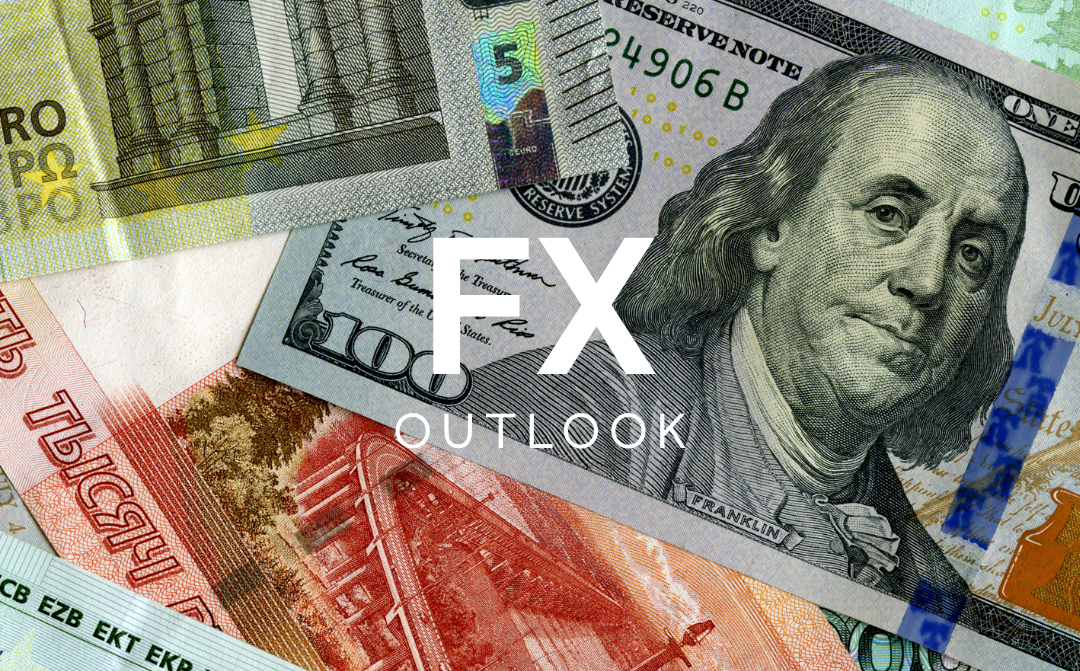11 Dec FX outlook – USD, EUR, GBP, CAD, AUD, NZD

Table of Content
US Dollar (USD)
The US dollar ended its 3-week down streak and became the second top-performing currency after the Japanese Yen. This was a result of heightened speculation about whether the Fed could indeed push 125-basis points worth of rate cuts next year. The dollar index (DXY), climbed 0.77% over the course of the week, helping drive hopes of a recovery after only recently falling to a four-month low. Particular dollar strength was enjoyed against the Australian and New Zealand dollar, with risk-off sentiment hurting these pro-cyclical currencies in favour of haven assets.
Last week saw risk-off flows help lift the US dollar, as the momentum for an early rate decrease was impeded by improved economic data. The US economy continued to show indications of strength in November, with the ISM Services PMI figure expanding at a higher-than-expected rate of 52.7. Weakness from both the JOLTS job openings (8.73 million) and ADP payrolls (103k) brought concerns that perhaps the economy has started to deteriorate. However, Friday’s strong NFP report revealed that the economy does not appear to be slowing, with the US jobs report for November beating estimates (199K). Meanwhile, the US unemployment rate posted a welcome decline, falling from 3.9% to a four-month low of 3.7%. Finally, the average earnings figure remained static at 4%, although the monthly figure rose to a four-month high of 0.4%.
The economic calendar will be busy this week, with the Federal Reserve kicking off a period that sees four central banks deliberate on their next policy move. Before that, the US inflation data will be issued on Tuesday, which may provide a clue into the Fed’s interest rate decision on Wednesday. With energy prices having been hit hard lately, there is a hope that the disinflation pathway continues swiftly. The Fed is projected to keep rates at 5.50%, underpinned by a cautious tone in its forward guidance, which might extend the US dollar’s current comeback. The dollar could be highly responsive to any shift in outlook for rate cuts, with the release of the Dot Plot likely key to determining whether the significant gap between market expectations and previous Fed communications could be bridged.
Euro (EUR)
The euro saw a mixed past week, with the single currency attempting to regain lost ground towards the back end of last week. A flat performance against their neighbours saw EURGBP struggle for direction. However, EURUSD and EURCAD saw the euro lose ground as capital flowed away from the euro. On the flip-side, the weakness of the AUD and NZD saw EURNZD and EURAUD move higher as risk-off sentiment hurt the two Oceanic currencies.
The topic of economic growth has been one of the euro’s key worries this year. Despite exhibiting hints of improvement, the zone’s latest service PMI data remained in contraction territory. German manufacturing orders dipped -3.7% month on month after an upward revision of 0.7%, while monthly retail sales fell 0.1% short of expectations. Furthermore, GDP growth in Q3 was negative (-0.1%) when compared to Q2.
Investors will be looking forward to the ECB’s monetary policy decision this Thursday, with Christine Lagarde expected to keep rates flat again. The weakness of the eurozone economy, and mere 2.4% inflation rate means that we could see the bank take on a notably dovish tone as the risk of below-target inflation comes into play. This will be followed by other updates on the bloc’s services and manufacturing PMI data, which might give additional support for the EUR if the report beats expectations.
Canadian Dollars (CAD)
The Canadian currency showed resilience last week, gaining ground against other commodity currencies (NZD, AUD) as the Bank of Canada maintained a hawkish stance on monetary policy. In a week that saw continued weakness in energy markets, CAD still managed to post gains across the currency spectrum. The one area of weakness came against haven assets, with the USD and JPY both gaining ground on the Loonie.
Last Wednesday saw the Bank of Canada (BoC) help ease calls for a swift return to monetary easing next year, noting that inflation remained a major worry notwithstanding a slowdown in economic growth and easing of pricing pressures. Having said that, the door has been left open for additional rate hikes if inflationary pressures do not subside. The central bank has made great headway towards its 2% inflation objective, with the latest data standing at 3.1%. That is well below the 8.1% peak seen last year. Furthermore, the Ivey Purchasing Managers Index offered more support to the CAD as estimates showed the economy expanded at a rapid clip in November (54.7 versus 53.4).
This week, the economic calendar will provide few key drivers for the CAD, as it will be subject to other central bank actions (FOMC/BoE/SNB/ECB) and top-tier market reports (CPI) from other economies. There will be a focus on the BoC Governor’s comments on Friday, coming off the back of last week’s interest rate decision. Having said that, CAD weakness could reemerge because of declining oil prices caused by demand concerns, and record US crude oil production.
British Pounds (GBP)
The pound spent much of the last week on the back foot, with the gains seen throughout October and November starting to unravel. This was heavily driven by a risk-off mood within markets, as expectations over the timing and size of next year’s Fed rate cuts starting to unravel. With the Yen moving sharply higher, and the dollar finding itself back in favour, the weakness of the pound was largely driven by shifting risk attitudes. Interestingly, the pound managed to lose ground against the Canadian dollar despite continued weakness in energy prices.
From a data perspective, last week saw few notable data releases to drive sentiment. The latest construction PMI data highlighted the continued struggles for the sector, with a third heavy contraction reading now established (45.5). We also saw Bailey appear in the wake of the Bank of England’s (BoE) financial stability report, with the Governor warning that the full effects of higher rates could be yet to be felt. Thankfully, we saw a welcome decline in the quarterly consumer inflation expectations figure on Friday, although the view that we could see prices increase 3.3% over the coming year may highlight the need to do more to drive inflation down to target.
This week, the pound may be set for a volatile week as we weigh up a huge amount of data releases both in the UK and within other key trading partners. From a UK perspective, the jobs report due on Tuesday kicks off proceedings, with average earnings providing a particular focus given the worryingly high (7.9%) wages being paid by businesses. Wednesday sees a raft of UK data, with the monthly GDP at risk of a move into negative territory according to some market predictions. However, the main event should be on Thursday, with the Bank of England rate decision likely to see significant movement in terms of interest rate expectations going forward. Friday wraps up the week, with the leading PMI surveys that could provide insight into the health of the UK economy. With both manufacturing and services expected to move higher, any signs of economic strength should allow the BoE further room to maintain rates elevated in a bid to drive down inflation.
Australian Dollar (AUD)
Last week was a somewhat mixed week for the Australian dollar that saw losses on Monday and Tuesday. The U-shaped performance of the Australian dollar witnessed the currency lose ground across the board in the days leading up to Wednesday, with AUD finding its feet to recover over the final two days of last week. With markets having a more hesitant tone compared to that seen throughout November, risk-off attitudes saw particular weakness for AUDUSD. While the Aussie dollar managed to regain much of the lost ground against the pound, euro, and kiwi, it was the CAD which managed to outperform despite falling energy prices.
Last week was a tale of two halves, that came as a reflection of the data released mid-week, with the RBA rate decision (Tuesday) and GDP (Wednesday) serving to spark volatility for the AUD. The RBA decision to keep rates steady came as no surprise, although the somewhat dovish tone did surprise markets that have since pulled forward expectations for the first rate cut. Not long ago markets were instead expecting a final rate hike in the coming months. With the third quarter GDP figure coming in well below estimates, markets are now looking for a potential first hike in August.
This week, Monday kicks off with an appearance from Michele Bullock, which could help further shape rate expectations going forward. Things could gather momentum on Wednesday evening, with inflation expectations and the Australian jobs report due. We are yet to see any signs of distress for the Australian jobs market, with monthly fluctuations in the employment change figure doing little to push unemployment higher. Also watch out for Thursday’s PMI data release, with both manufacturing and services sectors currently well into contraction territory.
New Zealand Dollar (NZD)
The Kiwi dollar had a somewhat tough past week, with the strength seen over the course of November starting to unravel a little. For the New Zealand dollar index, the currency suffered a rare weekly decline after three consecutive weeks of gains. The dominant losses were taken against havens such as the US dollar and Japanese yen, while the Canadian dollar also managed to gain ground against the Kiwi despite falling energy prices.
Looking back at the drivers of sentiment last week, there were few major releases to note. A decline in the ANZ commodity prices figure (-1.3%) brought concerns over the value of New Zealand exports after two months of positive growth. However, the Global Dairy Trade figure of 1.6% helped bolster expectations for agricultural exports. Unfortunately, the Chinese trade data did highlight some cause for concern, with imports (-0.6%) unexpectedly losing traction after an impressive 3% figure in October.
This week sees a particular focus on Wednesday’s New Zealand GDP release, with the second quarter growth figure expected to fall sharply after a lofty 0.9% figure in Q2. Should we see growth concerns emerge, there is a chance that the RBNZ could seek to bring forward the timing of their first rate cut which is currently pencilled in for July.
Disclaimer: This material is a marketing communication and shall not in any case be construed as an investment advice, investment recommendation or presentation of an investment strategy. The marketing communication is prepared without taking into consideration the individual investors personal circumstances, investment experience or current financial situation. Any information contained therein in regardsto past performance or future forecasts does not constitute a reliable indicator of future performance, as circumstances may change over time. Scope Markets shall not accept any responsibility for any losses of investors due to the use and the content of the abovementioned information. Please note that forex trading and trading in other leveraged products involves a significant level of risk and is not suitable for all investors.







